
A Study in Scarlet is an 1887 detective novel by British writer Arthur Conan Doyle. The story marks the first appearance of Sherlock Holmes and Dr. Watson, who would become the most famous detective duo in literature. The book's title derives from a speech given by Holmes, a consulting detective, to his friend and chronicler Watson on the nature of his work, in which he describes the story's murder investigation as his "study in scarlet": "There's the scarlet thread of murder running through the colourless skein of life, and our duty is to unravel it, and isolate it, and expose every inch of it."

Detective Inspector G. Lestrade, or Mr. Lestrade, is a fictional character appearing in several of the Sherlock Holmes stories written by Arthur Conan Doyle. Lestrade's first appearance was in the first Sherlock Holmes story, the novel A Study in Scarlet, which was published in 1887. The last story in which he appears is the short story "The Adventure of the Three Garridebs", which was first published in 1924 and was included in the final collection of Sherlock Holmes stories by Doyle, The Case-Book of Sherlock Holmes.

"The Adventure of the Dying Detective", in some editions simply titled "The Dying Detective", is one of the 56 Sherlock Holmes short stories that were written by Sir Arthur Conan Doyle. It was originally published in Collier's in the United States on 22 November 1913, and The Strand Magazine in the United Kingdom in December 1913. Together with seven other stories, it was collected in His Last Bow.
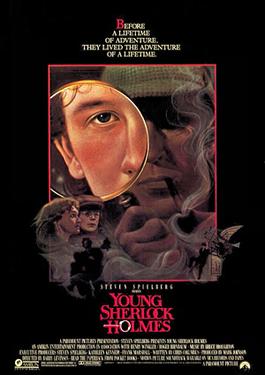
Young Sherlock Holmes is a 1985 American mystery adventure film directed by Barry Levinson and written by Chris Columbus, based on the characters created by Sir Arthur Conan Doyle. The film depicts a young Sherlock Holmes and John Watson meeting and solving a mystery together at a boarding school.

A Study in Terror is a 1965 British thriller film directed by James Hill and starring John Neville as Sherlock Holmes and Donald Houston as Dr. Watson. It was filmed at Shepperton Studios, London, with some location work at Osterley House in Middlesex.
Sherlock Holmes has long been a popular character for pastiche, Holmes-related work by authors and creators other than Arthur Conan Doyle. Their works can be grouped into four broad categories:

The Hound of the Baskervilles is a 1981 Soviet television film adaptation of Arthur Conan Doyle's 1902 novel The Hound of the Baskervilles. It was the third instalment in the TV series about adventures of Sherlock Holmes and Doctor Watson.
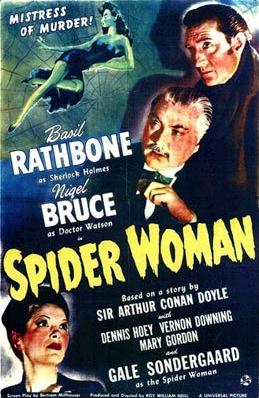
The Spider Woman is a 1943 mystery film starring Basil Rathbone as Sherlock Holmes and Nigel Bruce as Dr. Watson, the seventh of fourteen such films the pair were involved in. As with all of the Universal Studios films in the series, the film is set in then-present day as opposed to the Victorian setting of the original stories. This film incorporates elements from the 1890 novel The Sign of the Four, as well as the short stories "The Final Problem", "The Adventure of the Empty House", "The Adventure of the Speckled Band" and makes explicit reference to "The Adventure of the Devil's Foot".

The Hound of the Baskervilles is a 1939 American gothic mystery film based on the 1902 Sherlock Holmes novel of the same name by Sir Arthur Conan Doyle. Directed by Sidney Lanfield, the film stars Basil Rathbone as Sherlock Holmes and Nigel Bruce as Dr. John Watson. Released by 20th Century Fox, it is the first of fourteen Sherlock Holmes films produced between 1939 and 1946 starring Rathbone and Bruce.
"A Study in Emerald" is a short story written by British fantasy and graphic novel author Neil Gaiman. The story is a Sherlock Holmes pastiche transferred to the Cthulhu Mythos universe of horror writer H. P. Lovecraft. Gaiman describes it as "Lovecraft/Holmes fan fiction". It won the 2004 Hugo Award for Best Short Story. The title is a reference to the Sherlock Holmes novel A Study in Scarlet.
The Hound of the Baskervilles is a 2002 television adaptation of Sir Arthur Conan Doyle's 1902 novel of the same name.

The House of Fear is a 1945 Sherlock Holmes crime film starring Basil Rathbone and Nigel Bruce. Directed by Roy William Neill, it is loosely based on the 1891 short story "The Five Orange Pips" by Arthur Conan Doyle. It is the 10th film of the Rathbone/Bruce collaboration as Holmes and Dr. Watson.
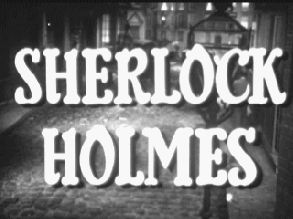
Sherlock Holmes was a detective television series syndicated in the autumn of 1954, based on the Sherlock Holmes stories of Arthur Conan Doyle. The 39 half-hour mostly original stories were produced by Sheldon Reynolds and filmed in France by Guild Films, starring Ronald Howard as Holmes and H. Marion Crawford as Watson. Archie Duncan appeared in many episodes as Inspector Lestrade. Richard Larke, billed as Kenneth Richards, played Sgt. Wilkins in about fifteen episodes. The series' associate producer, Nicole Milinaire, was one of the first women to attain a senior production role in a television series.

Sherlock Holmes and the Secret Weapon (1942) is the fourth in the Basil Rathbone/Nigel Bruce series of 14 Sherlock Holmes films which updated the characters created by Sir Arthur Conan Doyle to the then present day. The film is credited as an adaptation of Conan Doyle's 1903 short story "The Adventure of the Dancing Men," though the only element from the source material is the dancing men code. Rather, it is a spy film taking place on the background of the then ongoing Second World War with an original premise. The film concerns the kidnapping of a Swiss scientist by their nemesis Professor Moriarty, to steal a new bomb sight and sell it to Nazi Germany. Sherlock Holmes and Dr. John Watson have to crack a secret code in order to save the country.

Sherlock Holmes Faces Death is the sixth film in the Basil Rathbone/Nigel Bruce series of Sherlock Holmes films. Made in 1943, it is a loose adaptation of Sir Arthur Conan Doyle's 1893 Holmes short story "The Adventure of the Musgrave Ritual". Its three immediate predecessors in the film series were World War II spy adventures with Holmes and Dr. Watson helping the Allie sto thwart enemy agents, but this one marked a return to the pure mystery film form. Though several characters are military men and there are frequent mentions of the ongoing war, it is not the focus of the story.
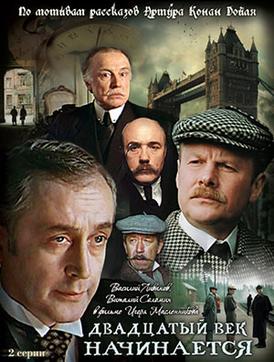
The Twentieth Century Approaches is a 1986 Soviet film adaptation of Arthur Conan Doyle's stories about Sherlock Holmes. It is the fifth and final film in The Adventures of Sherlock Holmes and Dr. Watson film series directed by Igor Maslennikov.

The Sleeping Cardinal, also known as Sherlock Holmes' Fatal Hour in the United States, is a 1931 British mystery film directed by Leslie S. Hiscott and starring Arthur Wontner and Ian Fleming. The film is an adaptation of the Sherlock Holmes stories by Arthur Conan Doyle. Although it is not based on any one particular story, the film draws inspiration from "The Empty House" and "The Final Problem". The film is the first in the 1931–1937 film series starring Wontner as Sherlock Holmes. It is unrelated to the Basil Rathbone series of Sherlock Holmes films that began in the late 1930s.

The Hound of the Baskervilles is a 1983 British made-for-television mystery thriller film directed by Douglas Hickox, starring Ian Richardson as Sherlock Holmes and Donald Churchill as Dr. John H. Watson. It is based on Arthur Conan Doyle's 1902 novel The Hound of the Baskervilles.
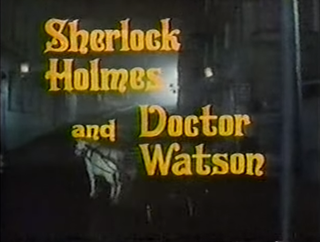
Sherlock Holmes and Doctor Watson is a television series created by Sheldon Reynolds and based on characters and storylines from Sir Arthur Conan Doyle's Sherlock Holmes stories. It starred Geoffrey Whitehead, Donald Pickering and Patrick Newell in the title roles of Sherlock Holmes, Doctor Watson and Inspector Lestrade respectively. The series is considered rather obscure, and was filmed on a relatively low budget in Poland. The series combined adaptations of Arthur Conan Doyle's source stories with original screenplays that saw Holmes face brand new cases.

Sherlock in Russia is a Russian detective TV series based on Arthur Conan Doyle's stories about the legendary detective Sherlock Holmes. This is the third Russian adaptation of the character and the first with original script. The series was released in October 2020 on the Start.ru streaming service.
















